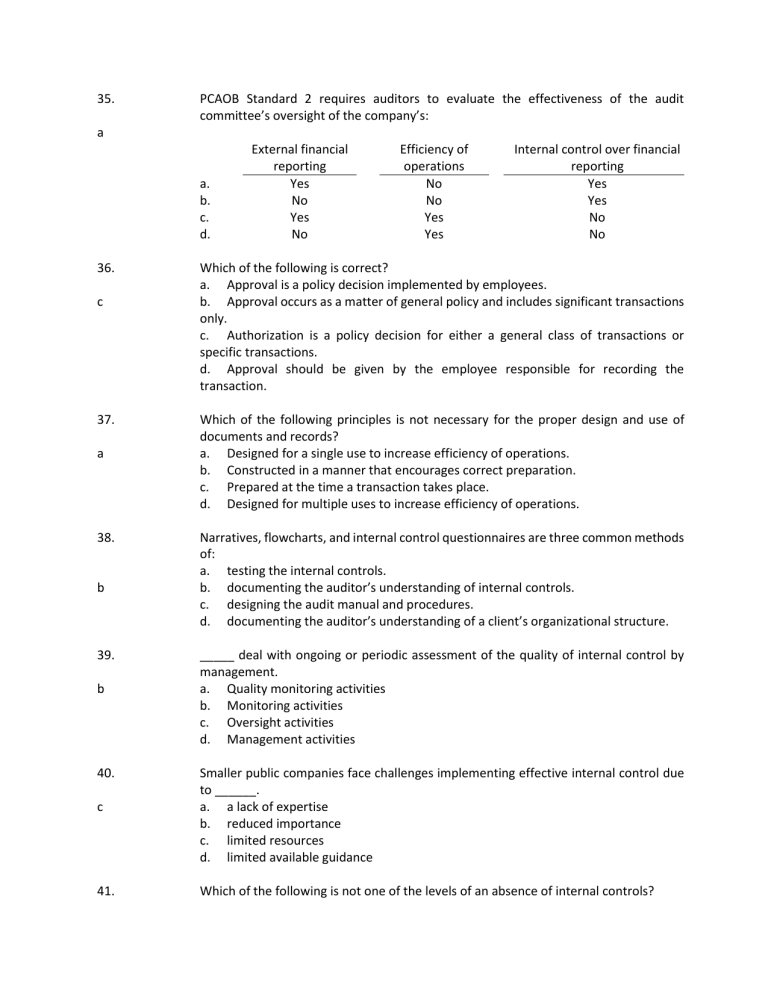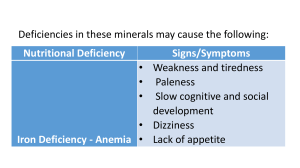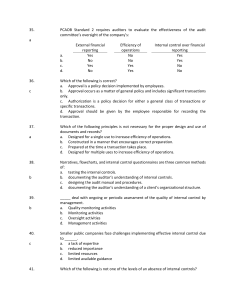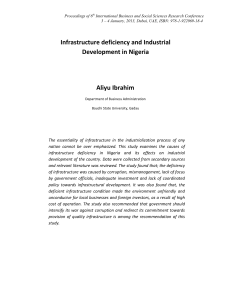
35. PCAOB Standard 2 requires auditors to evaluate the effectiveness of the audit committee’s oversight of the company’s: a a. b. c. d. 36. c 37. a 38. b 39. b 40. c 41. External financial reporting Yes No Yes No Efficiency of operations No No Yes Yes Internal control over financial reporting Yes Yes No No Which of the following is correct? a. Approval is a policy decision implemented by employees. b. Approval occurs as a matter of general policy and includes significant transactions only. c. Authorization is a policy decision for either a general class of transactions or specific transactions. d. Approval should be given by the employee responsible for recording the transaction. Which of the following principles is not necessary for the proper design and use of documents and records? a. Designed for a single use to increase efficiency of operations. b. Constructed in a manner that encourages correct preparation. c. Prepared at the time a transaction takes place. d. Designed for multiple uses to increase efficiency of operations. Narratives, flowcharts, and internal control questionnaires are three common methods of: a. testing the internal controls. b. documenting the auditor’s understanding of internal controls. c. designing the audit manual and procedures. d. documenting the auditor’s understanding of a client’s organizational structure. _____ deal with ongoing or periodic assessment of the quality of internal control by management. a. Quality monitoring activities b. Monitoring activities c. Oversight activities d. Management activities Smaller public companies face challenges implementing effective internal control due to ______. a. a lack of expertise b. reduced importance c. limited resources d. limited available guidance Which of the following is not one of the levels of an absence of internal controls? a a. b. c. d. Major deficiency. Material weakness. Significant deficiency. Control deficiency. 42. a Which of the following is the correct definition of “control deficiency?” a. A control deficiency exists if the design or operation of controls does not permit company personnel to prevent or detect misstatements on a timely basis. b. A control deficiency exists if one or more deficiencies exist that adversely affect a company’s ability to prepare external financial statements reliably. c. A control deficiency exists if the design or operation of controls results in a more than remote likelihood that controls will not prevent or detect misstatements. d. A control deficiency exists if the design or operation of controls results in a more than probable likelihood that controls will prevent or detect misstatements. 43. A(n) _______ deficiency exists if a necessary control is missing or not properly formulated. a. control b. significant c. design d. operating c 44. To determine if significant internal control deficiencies are material weaknesses, they must be evaluated on their: a a. b. c. d. 45. Likelihood Yes No Yes No The purpose of an entity’s accounting information and communication system is to ______. d a. b. c. d. 46. b Significance Yes No No Yes Monitor transactions Yes No Yes No Record and process transactions Yes No No Yes Initiate transactions Yes No No Yes A procedure that would most likely be used by an auditor in performing tests of control procedures that involve segregation of functions and that leave no transaction trail is: a. inspection. b. observation. c. reperformance. d. reconciliation. 47. b 48. b 49. d 50. d If the results of tests of controls support the design and operations of controls as expected, the auditor uses ____ control risk as the preliminary assessment. a. a lower b. the same c. a higher d. either a lower or higher Internal controls normally include procedures designed to provide reasonable assurance that: a. employees act with integrity when performing their assigned tasks. b. transactions are executed in accordance with management’s authorization. c. decision processes leading to management’s authorization of transactions are sound. d. collusive activities would be detected by segregation of employee duties. Which of the following is correct? a. A significant deficiency is always a material weakness. b. A control deficiency is always a material weakness. c. A material weakness is less significant that a control deficiency. d. A material weakness is always a significant deficiency. Which of the following is not a likely procedure to support the operating effectiveness of internal controls? a. Inquiry of client personnel. b. Observation of control-related activities. c. Reperformance of client procedures. d. Completing an internal control questionnaire.


